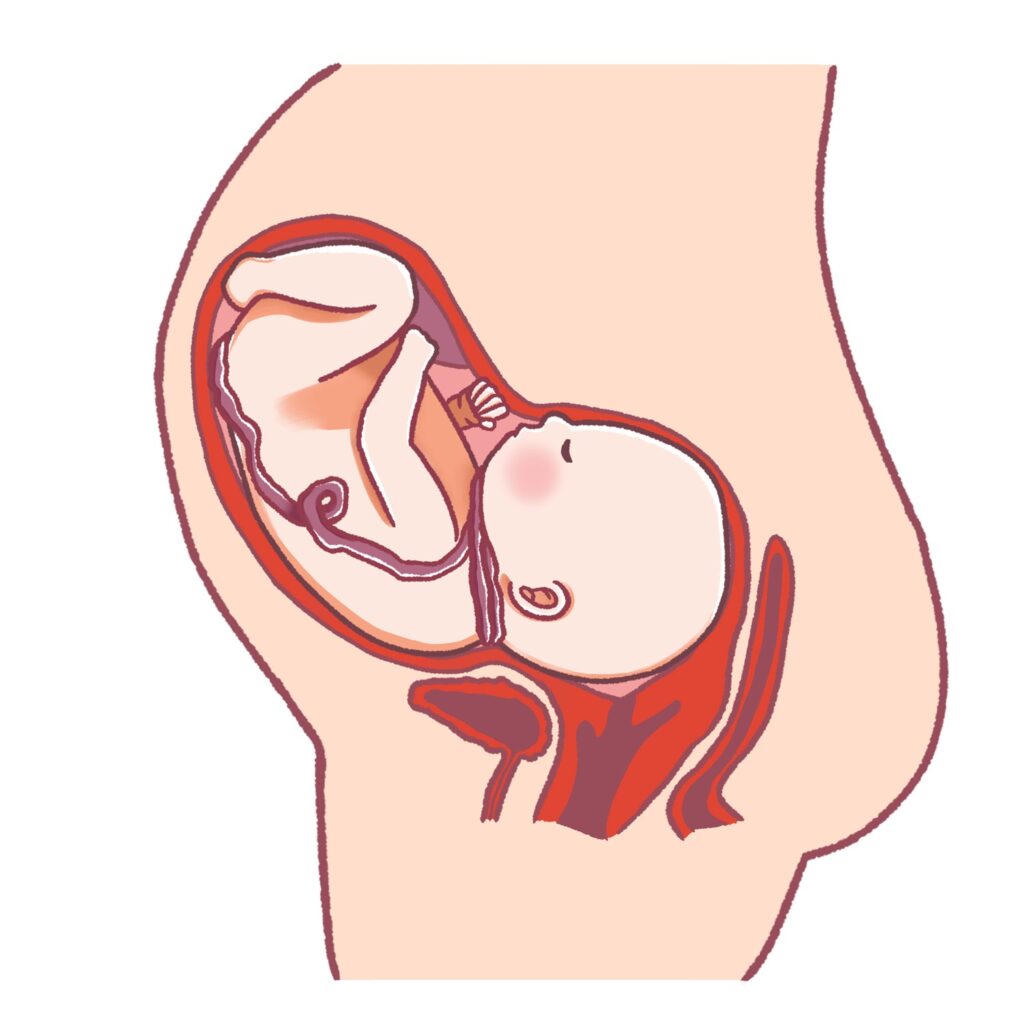A nuchal cord is a medical condition where the umbilical cord becomes wrapped around the baby’s neck during pregnancy or labor. The term ‘nuchal’ originates from the Latin word ‘nucha,’ which refers to the ‘nape of the neck’ or the ‘back of the neck.’ This results in the formation of a loop known as the nuchal cord.
It is hard to harm the umbilical cord because it is sheathed by a protective, gristle-like substance called Wharton’s Jelly, which acts as a cushion and prevents compression of the blood vessels within the cord. Therefore, it is challenging for the baby to harm the umbilical cord, even if it becomes wrapped around the neck.
Nuchal cords are commonly observed and occur in approximately 20%[1] of normal deliveries. Generally, the presence of a single loose loop is rarely associated with adverse risks. However, as the number of loops around the neck increases, the likelihood of adverse outcomes also rises. Despite the initial concern that a nuchal cord diagnosis might cause parents, it is essential to note that severe side effects or stillbirths due to nuchal cords are extremely rare.
Causes
The exact cause of nuchal cords is not fully understood. Several factors may contribute to this occurrence:
Fetal Movement: Random fetal movements appear to be the primary cause of a nuchal cord. Babies play with their cords all the time. They grab the cord, swim around, and sometimes they get tangled in the cord.
Long Umbilical Cord: In some cases, a longer-than-average umbilical cord can increase the likelihood of looping around the baby’s neck.
Multiple Pregnancies: Nuchal cords are more common in multiple pregnancies (twins, triplets, etc.) due to the limited space and increased movements of multiple fetuses.
Amniotic Fluid Volume: Excessive amniotic fluid may increase the risk of nuchal cords, as there is more room for the baby to move and potentially entangle the cord.
Baby’s Position: The baby’s position in the womb can also play a role. For example, breech presentation (feet or buttocks first) or transverse lie (sideways position) may increase the chances of a nuchal cord.
Risks Involved
Nuchal cords become problematic when the cord is wrapped tightly around the baby or has multiple loops. The risks involved with a nuchal cord may include:
Reduced Blood Flow: If a nuchal cord tightens in utero, this may compress the umbilical cord, reducing blood flow to the baby. This can decrease the fetus’s oxygen and nutrient supply, potentially leading to fetal distress. In some cases, a cord may tighten around the baby’s neck during labor, potentially leading to compression of the cord and compromising blood flow. This may result in an emergency intervention such as a cesarean section to ensure the baby’s safe delivery.
Abnormal Heart Rate: A nuchal cord can cause temporary fluctuations in the baby’s heart rate during labor, which may necessitate continuous monitoring and further medical intervention.
Cord Prolapse: If the nuchal cord is positioned ahead of the baby during delivery, it can lead to cord prolapse, where the cord emerges from the birth canal before the baby. Cord prolapse is a medical emergency that requires immediate attention to avoid potential complications.
Treatment
There is no current known way to prevent or treat nuchal cords. When a nuchal cord is detected during pregnancy, doctors may monitor the situation through regular ultrasound examinations to assess the baby’s growth and well-being.
In many cases, the cord is wrapped loosely enough to slip over the baby’s head naturally. During the delivery process, the practitioner will ask the mother not to push while carefully maneuvering the umbilical cord from around the baby’s neck. If the cord is wrapped too tightly and poses a risk, the practitioner will clamp and cut the cord before the baby is fully delivered. However, it’s important to note that cutting the cord in such situations is very rare and may only happen a handful of times during a practitioner’s career.
Whenever there is a reason for concern, the doctor may recommend a cesarean birth to ensure the safety of both the mother and the baby. It’s essential to remember that experiencing a nuchal cord in one pregnancy does not necessarily imply that future pregnancies will have the same condition.
Medical professionals are well-trained to handle situations involving nuchal cords and other pregnancy-related concerns. Trusting in the expertise and experience of your healthcare team can provide reassurance and confidence throughout the journey of pregnancy and childbirth.
Author: Karen Synesiou, Infertility Portal, Inc.
[1] A, Biron-Shental T. Multiple nuchal cord loops and neonatal outcomes. American Journal of Obstetrics and Gynecology. 2018;218(1):S91. doi:10.1016/j.ajog.2017.10.104


